Il marchio Bertram
History of the Bertram brand
In the history of sport, there are few individuals who have achieved success in multiple sections of the same discipline, especially those that are as different as motorboat racing and sailing. In nautical sports it is practically unheard of, with the exception of one man, the winner of several sailing championships, including America's Cup, who also appeared three times on the motorboat racing podium: Richard "Dick" Bertram.
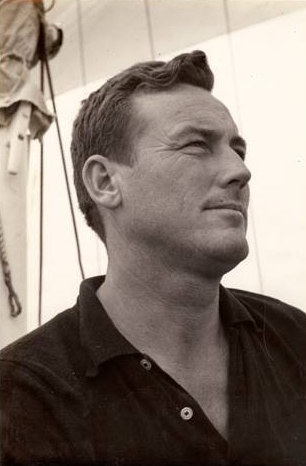
The Sailor
To call him versatile is to do him an injustice. In addition to being a great sportsman, he also had the ability to combine his immense passion for the sea and competitions with a great understanding of business, creating two of the most important companies in the history American boating: Richard Bertram & Company, one of the most prestigious brokerage companies of the time, and later the shipyard that, in spite of numerous changes of ownership, still bears his name, synonymous with deep-V hull fishing yachts.
In 1964, Time compared Bertram to Enzo Ferrari, as he drew on his success in the world of racing to create the winning combination of luxury and performance, much as "il Drake" had done on the Formula One track. Dick Bertram's passion for the sea and for competition was an integral element of his character. This competitive nature found an outlet, as is often the case for such important figures, when he was a child, taking up sailing at just eight years old, making a name for himself with his first regatta just two years later. While studying at university, he founded an association within the college in order to participate in the student sailing championships, winning for two consecutive years in 1936 and 1937. His success continued when he moved to Miami from New Jersey, winning the Lightning class championship (the one-design class created by Olin Stephens) in 1948 and 1949, and he also took part in what was then considered one of the toughest races on the open seas: the Newport to Bermuda Ocean Race, a 635 mile race on the high seas, winning it three times and appearing near the top of the leader board on seven other occasions, as well as winning or placing high six times in the Lipton Cup, four times in the Trans Atlantic Race and twice in the Buenos Aires-Rio de Janeiro race, becoming one of the best regatta racers of his day.
As well as being an excellent seafarer, Dick Bertram was also an intelligent man with an active and brilliant mind. He used his reputation as a yachtsman with an in-depth knowledge of boats acquired on the race course to establish his own brokerage company, which earned him worldwide recognition as a businessman over and above his fame as a yacht builder.
It was during a period of intense yachting activity in 1958 that he was aboard Vim, an international 12-metre class yacht, training for the America's Cup, when he noticed a small boat, just over seven metres long, with a strange hull with big "whiskers", taking on two-foot high waves and a wind of over twenty knots with an ease that seemed like something out of science fiction.
As soon as Dick finished his work, he immediately wanted to find out more about this mysterious vehicle; he was told that it was the tender for another of the 12-class yachts in the bay, from a designer named Charles Raymond Hunt.
Bertram had already participated in motorboat competitions with his friend Sam Griffith, considered one of the fathers of the modern offshore race, winning the first two editions of the Miami-Nassau competition (in 1956 with a 34' Chris Craft and in 1957 with a 35' Enterprise, both wooden), which is still considered one of the most difficult motorboat races in the world for boats and crews alike. Bertram commissioned Hunt with the design of his personal 30' wooden boat, using the same 24° V monohedron hull that he had seen tackling the waves in Rhode Island Bay, and called it "Moppie" (after his wife's childhood nickname).
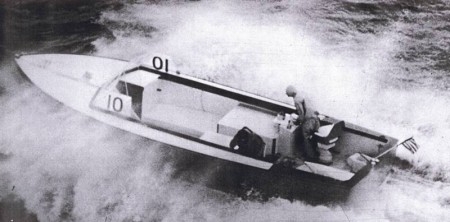
On the day of Moppie's launch he wanted to test it out with Sam, his friend and racing partner, who would not go easy on the vehicle and would give him an expert opinion. Bertram's description of that test drive is one of the most beautiful chapters in the history of motorboat racing. He remembered that the conditions of the sea (ocean) were particularly tough that day: strong winds with gusts over 30 knots, and solid waves more than two metres tall. He entrusted the boat to the experienced Griffith, who had never sailed a deep-V hull boat before, and therefore could not know its potential.
Faced with the first waves, Griffith instinctively reduced power to the engines, noting that the boat had no difficulty in overcoming them despite their size. "After the third wave," Bertram recalled, "Sam started smiling and eased forward the throttles, while Moppie gained speed, moving incredibly softly compared to a conventional hull." It was the beginning of the age of the deep-V!
That very same year, Moppie took part in Miami-Nassau, easily defeating and outdistancing the competition (there were two hours between Moppie and the boat that came in second, another smaller craft also designed by Hunt with sterndrive propulsion, unheard of at the time). From that moment on, Bertram received numerous requests for boats with the same hull and, despite his initial reticence, he was inspired to found his own shipyard. Bertram immediately realised that to meet such high levels of demand, he would need to come up with a different production process, rather than conventional wooden construction. He settled on the composite construction method that had been well-established in the US since the 1940s, guaranteeing lower production times and costs and greater precision in terms of uniform manufacturing.
Bertramyachts and the offshore epic
He used Moppie as a model to make a mould, producing a composite prototype of the boat, which he named Glass Moppie. He took this new boat to the next edition of Miami-Nassau, achieving even greater success on a calm sea, destroying the course's previous record, also set by Bertram in his partnership with Griffith, halving it from eight to four hours!
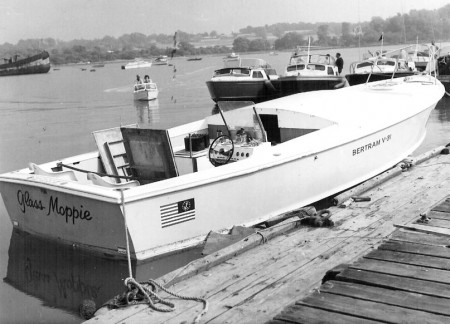
From 1961 onwards, Bertram hulls dominated ocean motorboat racing competitions. Dick Bertram used his business acumen to ride the wave of success, agreeing to requests from brands such as Rolex and Camel cigarettes, which soon saw him appearing on billboards in Times Square, the heart of American and global economic power. The first pleasure boat model produced by Bertram production was, of course, based on the 31' Moppie hull, resulting in a boat that is particularly well-suited to deep sea fishing due to its remarkable maritime qualities. It also featured a totally glazed deck in a very advanced position, not beautiful to look at, but guaranteeing absolute protection in any sea conditions and 360° visibility. In order to make the lines of this exceptional boat more attractive, making it more appealing to pleasure boat buyers, a small flying bridge was added to the ample deckhouse, and an icon of nautical design was born: the famous Bertram 31, forefather of the renowned Bertram fishing yacht family, presented for the first time during the 1961 New York Boat Show.
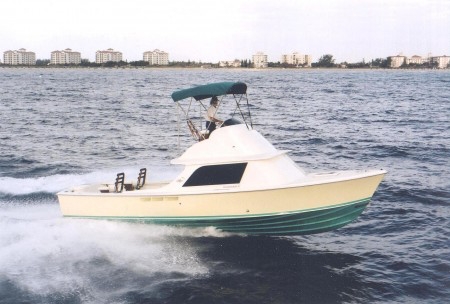
The success of the Bertram 31' is the stuff of legends. The mould was used to create 1860 examples over sixteen years of production, of which 23 were special editions, becoming a landmark in terms of seakeeping and durable construction, so much so that several are still sailing to this day. In 1962, the shipyard's production range expanded to include a 25' vessel with Mercruiser sterndrives, also derived from a prototype developed and tested on the race course, a 38' vessel in 1963, and a small 20' with the option of either outboard or sterndrive motorisation; in 1971, only ten years from the start of production, Bertram Yachts built its 1000th boat! Legend has it that Bertram's boats sold themselves, as every yachtsman who tried them out was so impressed by their abilities on the rough seas that they could not go bear to go back empty-handed.
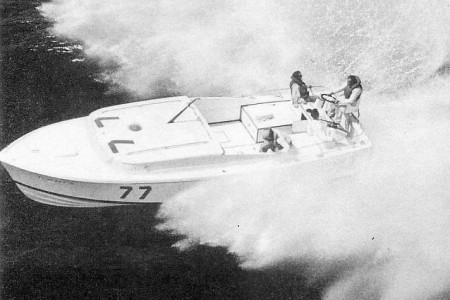
A tremendous achievement for the time! Over the years, the Bertram brand became synonymous with luxury, sportsmanship, speed and safety, but, above all, its founder's incredible business and communication skills helped it to gain in popularity, counting the likes of Aristotle Onassis, King Hussein of Jordan and Prince Bertil of Sweden among its customers. Griffith passed away from cancer in 1963, but Dick Bertram did not give up offshore competitions. In fact, he built a new boat, also designed by Ray Hunt, called Lucky Moppie, with which he decided to compete in Europe, taking part in Viareggio-Bastia-Viareggio in 1964, going head-to-head with "A Speranzella", designed by Levi and piloted by Vincenzo Balestrieri. He also came second in the even more demanding Cowes-Torquay event, having kept pace with the twin hull of the "Surfrider", piloted by the Gardner brothers, for several hundred miles. Bertram won the Sam Griffith Trophy in 1965, named in honour of Dick's friend and racing partner, piloting a new 36' vessel called Brave Moppie, with which he returned to Viareggio-Bastia-Viareggio, came in second at Cowes-Torquay, and won the Miami-Key West race. In 1966, while competing with "Brave Moppie" in the competition in memory of his friend Griffith, Bertram's boat sank. This was a significant blow to his company's image, his finances, and likely weakened his enthusiasm for offshore racing, so much so that his presence in competitions became less frequent and more sporadic.
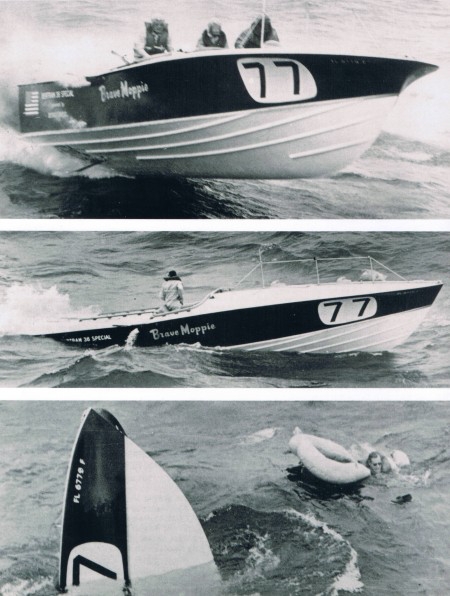
Il ritiro
Bertram sold the shipyard to Peter Rittmeister in 1969, who had resumed competing in offshore competitions from 1967 to 1969, still using the historical name "Moppie", but never living up to the results of his predecessor; subsequently, ownership passed to the Whittaker Corporation, under whose management the brand ceased participate in motorboat racing competitions, leaving Don Aronow's Cigarettes, Donzis and Magnums to dominate the field. In 1998, the Bertram brand was acquired by the Ferretti Group, who stayed true to the shipyard's design and construction philosophy, modernising the designs and the entire range, eventually manufacturing fishing yachts up to 80'. On 28 April 2000, Dick Bertram died at the age of 84, leaving behind the legacy of a versatile man who lived his life as a continuous race with himself, constantly seeking his own limits, to know them and overcome them. An enlightened mind that recognised innovation at first sight, even when it was invisible to everyone else, and who knew how to promote it and bring it to a wider audience. He took a gamble and won hands down. A dreamer with an indomitable temperament, truly unique, a visionary who led the way in both the construction of his boats and his business, whose insights are still being followed in the field of brokerage over half a century later.
An entrepreneur who saw far beyond the finish line.
